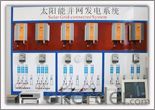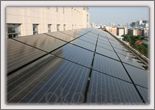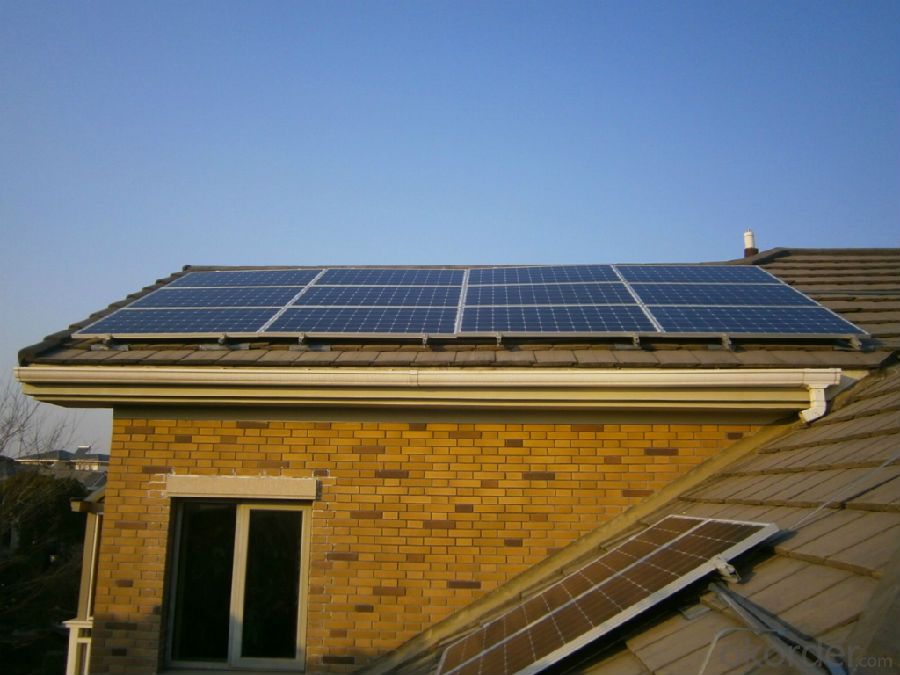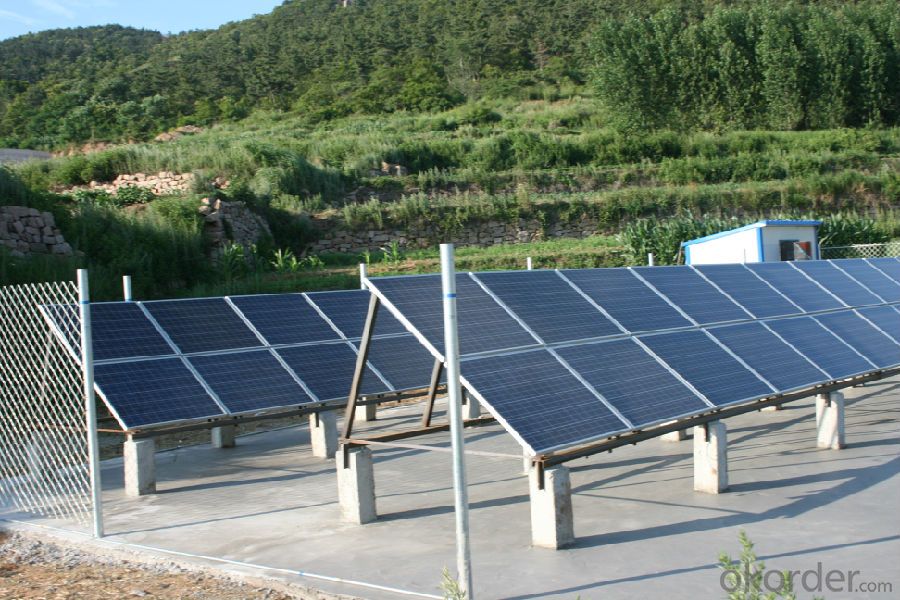Solar On Grid Inverters, Grid Tied Solar Inverter
- Loading Port:
- Shekou
- Payment Terms:
- TT or LC
- Min Order Qty:
- 20 unit
- Supply Capability:
- 800000 unit/month
OKorder Service Pledge
OKorder Financial Service
You Might Also Like
Solar On Grid Inverters, Grid Tied Solar Inverter
Products
Solar On Grid Inverter controls the whole system. Solar Inverters converts the DC current produced by the solar array into AC current, then the Solar On Grid Inverters transfers AC current to the grid, and adjusts the operation point in real-time according to the variation of sunshine to realize the maximum power point tracking (MPPT).
Success Stories


Technical Features
Adopting the dynamic VI MPPT method which has independent intellectual property; fast response and stable operation.A modified anti-islanding detection method can effectively shorten the detection time whilst keeping a high power quality, remove the obstacles to the grid, and suitable for a multi-inverter system.
Digital control with full automatic running, data storage and completely protective function.
Save the daily operating data automatically and consult the operating data for 8 years. It is convenient for statistics and analysis.
Dormancy function, save energy and reduce abrasion.
New design of anodized aluminum case; pretty appearance; perfect cooling and shielding.
Through optimization of the design, On Grid Inverters is adopted with free cooling instead of fans, and then the Solar Home will reduces the maintenance costs.
Light in weight, small in size, flexible installation.
Product Specifications
| Model | GB1000B | GB1500B | GB2000B | GB2500B | GB3000B | GB4000B | GB5000B |
| DC Input | |||||||
| Max. Input Power | 1200 W | 1700W | 2300 W | 2800W | 3400W | 4500W | 5600W |
| Max. Open-Circuit Voltage | 400 V | 450 V | |||||
| Recommended MPP Voltage Range | 160 ~ 320 V | 160 ~ 360 V | |||||
| Max. Input Current | 7A | 8A | 10A | 11A | 12A | 16 A | 20A |
| Reverse Olarity Protection | Yes | ||||||
| Input Current Limit Protection | Yes | ||||||
| AC Output | |||||||
| Rated Output Power | 1000 W | 1500W | 2000 W | 2500W | 3000 W | 4000 W | 5000 W |
| Max. Output Power | 1100 W | 1650W | 2200 W | 2750W | 3300 W | 4400 W | 5500 W |
| Mains Voltage/Frequency | 230 V / 50Hz | ||||||
| Power Factor | >0.99 | ||||||
| Harmonic Distortion of Current | < 4% | ||||||
| Max. Efficiency | 95.00% | 95.00% | 95.20% | 95.20% | 95.30% | 96.10% | 96.20% |
| Efficiency In Europe | 94.10% | 94.10% | 94.40% | 94.40% | 94.50% | 95.20% | 95.40% |
| Anti-Islanding Protection | Yes (with National Patent) | ||||||
| Short Circuit Protection | Yes | ||||||
| Common Data | |||||||
| Isolation | No transformer | ||||||
| Protection Degree | IP52 | ||||||
| Cooling | Free convection cooling | ||||||
| Operating Temperature | -10 ℃ ~ +50 ℃ | ||||||
| Operating Humidity | 0 ~ 95 % | ||||||
| Communication Interface | RS232/RS485 | ||||||
| Dimensions(W*H*D) | 250*310*165mm | 250*310*200mm | 310 * 400 * 235 mm | ||||
| Weight (KG) | 8 | 8 | 9.5 | 9.5 | 10 | 17 | 17.5 |
| Certification | |||||||
| Applicable Safety Standard | EN 50178 | ||||||
| EMC | EN61000-3-2,EN61000-3-3,EN61000-6-1,EN61000-6-3 | ||||||
| Grid Monitoring | UL 1741,IEEE 929,VDE0126-1-1 | ||||||
| Warranty Period | 5 years | ||||||



- Q:Can a solar inverter be used in systems with different module types?
- Yes, a solar inverter can be used in systems with different module types. Solar inverters are designed to convert the direct current (DC) generated by the solar panels into alternating current (AC) that can be used to power various household appliances and be fed into the electrical grid. They are typically compatible with a wide range of module types, including monocrystalline, polycrystalline, and thin-film solar panels. However, it is important to ensure that the inverter's specifications and capacity align with the specific module types being used to ensure optimal performance and efficiency.
- Q:How do you choose the right brand of solar inverter?
- Choosing the right brand of solar inverter involves considering factors such as reliability, efficiency, warranty, compatibility with your solar system, and customer reviews. Researching and comparing different brands, their track record, and customer feedback can help in making an informed decision. Additionally, consulting with solar professionals or seeking recommendations from reputable sources can further aid in selecting the most suitable brand for your specific needs and budget.
- Q:How does a solar inverter handle frequency variations?
- A solar inverter handles frequency variations by continuously monitoring the grid frequency and adjusting its own output accordingly. It uses advanced control algorithms to maintain a stable output frequency, ensuring the smooth and synchronized integration of solar power into the grid.
- Q:Can a solar inverter be used in commercial or industrial applications?
- Yes, a solar inverter can be used in commercial or industrial applications. In fact, they are commonly utilized in these settings to convert the direct current (DC) generated by solar panels into alternating current (AC) that can power various electrical equipment and systems. Solar inverters enable efficient and reliable integration of solar energy into commercial and industrial operations, contributing to cost savings and environmental sustainability.
- Q:Can a solar inverter be used with different AC voltage systems?
- No, a solar inverter cannot be used with different AC voltage systems. It is designed to work specifically with a particular AC voltage system and attempting to use it with a different system can cause damage to the inverter and the connected appliances. It is important to ensure compatibility between the inverter and the AC voltage system before installation.
- Q:Can a solar inverter be used with a generator as a backup power source?
- Yes, a solar inverter can be used with a generator as a backup power source. The solar inverter can be connected to the generator's output, allowing it to convert the generator's AC power into usable DC power for charging the batteries or powering the solar energy system. This setup ensures uninterrupted power supply during periods of low solar generation or in case of power outages.
- Q:Are there any limitations on the number of solar panels that can be connected to a single inverter?
- Yes, there are limitations on the number of solar panels that can be connected to a single inverter. The maximum number of panels that can be connected depends on various factors such as the power rating of the inverter, the voltage and current ratings of the panels, and the configuration of the system. In general, the inverter should be able to handle the combined power output of all the connected solar panels. If the panels generate more power than the inverter can handle, it may lead to system inefficiencies, reduced performance, or even damage to the inverter. Additionally, the voltage and current ratings of the panels should be within the acceptable range of the inverter. If the panels have a higher voltage or current rating than what the inverter can safely handle, it may result in overloading or malfunctioning of the inverter. Furthermore, the configuration of the solar panels also plays a role in determining the limitations. Panels can be connected in series or parallel, and each configuration has its own requirements and limitations. The inverter needs to be compatible with the specific configuration being used. To ensure proper functioning and optimal performance, it is recommended to consult the manufacturer's guidelines and specifications for both the solar panels and the inverter. These guidelines will provide information on the maximum number of panels that can be connected to a single inverter and any other specific limitations or requirements that need to be considered.
- Q:Can a solar inverter be used with a solar-powered data center?
- Yes, a solar inverter can be used with a solar-powered data center. A solar inverter is an essential component that converts the direct current (DC) produced by solar panels into alternating current (AC) that can be used to power electrical equipment, including data centers. By integrating a solar inverter into the solar power system of a data center, the generated solar energy can be efficiently used to run the center's operations, reducing reliance on grid electricity and promoting sustainability.
- Q:Can a solar inverter be used with concentrated photovoltaic systems?
- Yes, a solar inverter can be used with concentrated photovoltaic systems. A solar inverter is responsible for converting the direct current (DC) electricity generated by the photovoltaic panels into alternating current (AC) electricity that can be used to power electrical devices. This conversion process remains the same regardless of the type of photovoltaic system being used, including concentrated photovoltaic systems. Therefore, a solar inverter is an essential component for converting the DC electricity produced by concentrated photovoltaic systems into usable AC electricity.
- Q:What are the safety features in a solar inverter?
- Playing a crucial role in the conversion of direct current (DC) electricity from solar panels to alternating current (AC) electricity, solar inverters, also known as photovoltaic (PV) inverters, are equipped with various safety features to ensure their safe and efficient operation. Among the primary safety features of a solar inverter is ground fault protection. This feature is designed to detect any leakage of current to the ground, which may indicate a fault in the system. If a ground fault is detected, the inverter will immediately shut down to prevent potential electrocution hazards. To safeguard against overvoltage situations, solar inverters are equipped with surge protection devices (SPDs). These devices divert excessive voltage spikes or surges to the earth, thereby protecting the inverter and other connected electrical equipment from damage. In the event of a grid power outage or blackout, solar inverters have anti-islanding protection. This feature ensures that the inverter automatically disconnects from the grid, preventing power backfeeding, which could pose a serious threat to utility workers attempting to repair the grid. Temperature monitoring is another crucial safety feature in solar inverters. With the potential for heat generation during operation, inverters are equipped with temperature sensors to monitor internal temperature. If the temperature exceeds the safe limit, the inverter will automatically shut down to prevent potential fire hazards. Additionally, solar inverters often incorporate built-in arc fault circuit interrupters (AFCIs). These devices are designed to detect and interrupt dangerous arc faults that may occur due to damaged or deteriorating wiring connections. By promptly stopping the flow of electricity, AFCIs help prevent electrical fires. Lastly, many solar inverters feature advanced monitoring and diagnostic systems. These systems provide real-time data and alerts, enabling users or installers to promptly identify and address potential safety issues. In conclusion, the safety features in a solar inverter are essential for ensuring the secure and reliable operation of the system. These features protect against electrical hazards, prevent damage to the inverter and connected equipment, and contribute to the overall safety of the solar power generation system.
1. Manufacturer Overview |
|
|---|---|
| Location | |
| Year Established | |
| Annual Output Value | |
| Main Markets | |
| Company Certifications | |
2. Manufacturer Certificates |
|
|---|---|
| a) Certification Name | |
| Range | |
| Reference | |
| Validity Period | |
3. Manufacturer Capability |
|
|---|---|
| a)Trade Capacity | |
| Nearest Port | |
| Export Percentage | |
| No.of Employees in Trade Department | |
| Language Spoken: | |
| b)Factory Information | |
| Factory Size: | |
| No. of Production Lines | |
| Contract Manufacturing | |
| Product Price Range | |
Send your message to us
Solar On Grid Inverters, Grid Tied Solar Inverter
- Loading Port:
- Shekou
- Payment Terms:
- TT or LC
- Min Order Qty:
- 20 unit
- Supply Capability:
- 800000 unit/month
OKorder Service Pledge
OKorder Financial Service
Similar products
New products
Hot products
Hot Searches
Related keywords
































